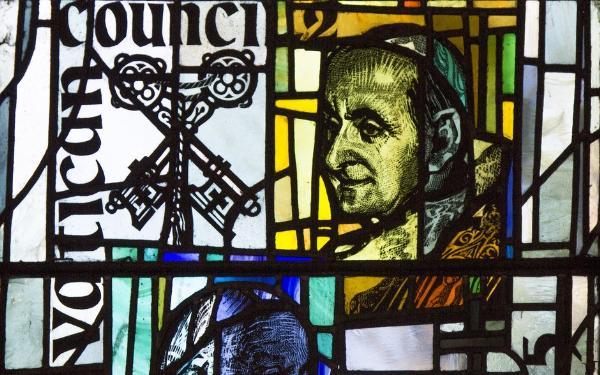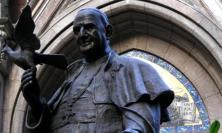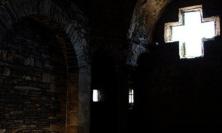As the Church celebrates the fiftieth anniversary of the opening of the Second Vatican Council, Oliver Rafferty SJ asks to what extent the council achieved the initial aims that were set for it by Pope John XXIII. What were the implications for the council of contemporary global events, and where are we now in relation to Vatican II?
There have been three periods in the history of the Church when Catholicism has experienced instances of profound destabilisation, three epochs when the very foundations of the Church seemed to shake if not fracture under the strain of societal transformation. These occasions witnessed individuals and groups within the Church questioning some of what were taken to be the foundational motifs of the faith, and this went hand in hand with large numbers of men and women abandoning the priesthood and religious life, accompanied by a good deal of questioning about the Church’s role in the world. These seminal historical epochs were: the Reformation and its aftermath; the French Revolution and its aftermath; and the Second Vatican Council and its aftermath. The consequences of all three continue to affect and shape Catholicism as we experience it today.
For our immediate experience of the Catholic Church the most important of these was Vatican II. It is tempting to think that Catholicism as we now live it has been utterly transformed by the Council. Perhaps it is better to say that our Catholic mentality has changed; that the way we think of the Church, our approach to authority and our responses to pronouncements of the Magisterium are radically different from how Catholics regarded these matters up until the late 1950s. A question arises, one that is debated widely among historians and theologians, of what Vatican II actually bequeathed to the Church. Did the Council which met at the Vatican every autumn from 1962 to 1965 envisage and give to the Church the culture of Catholicism as we now have it? What was Pope John XXIII’s intention in calling the Council and what did the bishops and their theological advisers seek to do in relation to the pope’s call for aggiornamento, an updating of the church?
We are accustomed to thinking that Pope John XXIII’s announcement of his intention to convoke a Council, in the course of an address to some cardinals on 25 January 1959, just three months after his election, came like a ‘bolt from the blue’. Indeed John XXIII himself wrote that the idea came to him ‘suddenly and unexpectedly’. However, even in the pontificates of Pius IX and Pius XII there was speculation about the possibility of a council, and in the case of Pius XII some preparation was undertaken by the Roman Curia with a view to a council being held. The task then envisaged was the completion of the work of Vatican I which had been suspended formally by Pope Pius IX in October 1870, following the outbreak of the Franco-Prussian war in July 1870 and the occupation of Rome by the Italian state in September.
There is some suggestion that Pope John may have discussed the possibility of a council with some of the cardinals in the conclave which elected him. He certainly spoke of it to his secretary within days of his elevation to the papacy. Some conservative cardinals such as Ernesto Ruffini, the Archbishop of Palermo, wanted a council to bring an end to what he took to be the dangerous theological liberalism that had been prevalent in certain ecclesiastical circles since the mid-1940s.
Having announced his intention to have a council it took quite some time for it to become clear precisely what the pope wanted the council to do. In November 1960 he expressed his hope that Vatican II would ‘affect a renewal of Faith’s strength, of doctrine and of ecclesiastical discipline’. By December the following year he said that the council would have three main aims: the better internal ordering of the Church; the promotion of world peace; and unity among Christians. This was to be a new council, not simply the continuation of Vatican I. Even with this clarification quite a lot of confusion remained as to what exactly the council would do to achieve its aims, and there were questions as to whether the idea of promoting peace in the world, no matter how laudatory as an objective, was really proper material for a Council of the Church. The pope also famously said that the council would be the means to open the windows of the Church to let in the fresh air of the Holy Spirit, and he further hoped that it would represent a new Pentecost. Equally there was nothing in Pope John’s background to indicate that he was in any sense a radical. His encyclicals and other writings as pope were all of a generally conservative nature. Even in his first encyclical, Ad Perti Cathedrum, he wrote with regard to Christian unity that he hoped that non-Catholics would see in Catholicism, ‘This wonderful spectacle of unity, by which the Catholic Church is set apart and distinguished’ and that this would ‘stir your hearts and awaken you to what is in your best interests’. He added: ‘May We hope with a father’s love for your return’ – certainly not the language of advanced ecumenical dialogue.
After nearly four years of preparation, much of it undertaken by the Roman Curia, the council got down to work. It produced in all sixteen documents, some immensely inspirational, others less so. Yves Congar OP, one of the great figures of the Council, once asked if Vatican II were too verbose; one can only respond with a thunderous ‘yes’. If we examine Norman Tanner’s edition of the Decrees of the Ecumenical Councils,we see that Vatican II’s decrees and documents occupy 315 pages; the other twenty Councils in the history of the Church account for 810 pages. For many ordinary Catholics the Council’s documents remain a closed book. Nevertheless, the impact of its teachings has permeated every aspect of contemporary Catholicism.
One of the most novel aspects of the council was the fact that it did not confine itself to theological, religious and disciplinary matters internal to Catholicism. It deliberated on social issues, questions of war and peace, and justice in the world. Moreover it stretched out the hand of fraternal love not simply to other Christians in the sprit of unity for which Christ prayed, but it also sought better relations with Judaism, with people of others faiths and with humanity in general. The council rejected ‘nothing of what is authentically human’, since ultimately all that is human comes from God.
In the years since Vatican II closed, three main interpretations have grown up in relation to it. For two ideological strands within the Church, the Council represents a radical break with the past. The ‘progressives’ welcome this, and see Vatican II as at last ending the Church’s isolation from other faith communities and as facilitating an accommodation with contemporary culture. For ‘traditionalists’, such as the late Archbishop Marcel Lefebvre and his followers, Vatican II represents a repudiation of the past, a repudiation which they abhor. A third element, the ‘reformists’, whilst recognising Vatican II as a watershed, do not believe that it represents a break with traditional Catholicism and they maintain that its documents have to be read and interpreted in terms of Catholic tradition as a whole. As long ago as 1969, Fr Henri de Lubac SJ, another key theologian at the Council, warned that even from the very beginning of the Council a ‘distorting interpretation’ of it had begun to spread. De Lubac’s view has been given further weight by both John Paul II and Pope Benedict XVI amid talk of the need to interpret Vatican II ‘authentically’.
The reformists can certainly point to the fact that, if we examine the documents of the Council, the source most often appealed to for guidance and confirmation of what the Council was teaching, next to the scriptures, was the writings and teachings of Pope Pius XII. For the progressive, however, Vatican II must be read in the light of what has happened since the Council. They tend to see Vatican II as the beginning of a continuous reform process within the Church and point to an old adage: ecclesia semper reformanda est (‘the Church is always being reformed’). To take but one example, the area that has most touched the lives of ordinary Catholics, liturgical reform. We can see that the present vernacular practices go well beyond what the Council had in mind. In the document on the liturgy, Sacrosanctum Concilium, the fathers say carefully and cautiously that Latin is to continue to be used in the Latin Church's rites, but more scope should be given to using the vernacular at Mass in ‘the readings and in instructions … in some prayers and in some of the singing’. This is not quite the wholesale liturgical reform we have experienced since the late 1960s.
The progressives maintain that ‘sometimes the inner logic or dynamism of a document carried it beyond its original delimitations’.[1] In other words, certain post-conciliar changes can be justified on the basis of the fact that, although not mentioned in the documents themselves, they have their origins perhaps only in embryonic form in the Council’s teaching. This in itself is not disingenuous, since in the history of councils it has often taken a long time to clarify what an individual council actually taught or intended. What is clear however, as John O’Malley concedes, is that so far as John XXIII, the ‘father of the council’, is concerned, ‘there is not the slightest shred of evidence that he foresaw or intended the direction [the Council] took’.[2]
It is also obvious that the Council was overtaken by events in the 1960s over which it had no control. Vatican II evolved its thinking and proclaimed its teaching in the context of a crisis of authority that became a hallmark of the 60s generation. The Council’s work had to be implemented against the background of the civil rights movement in the USA, the Vietnam War, the student riots in Paris and other cities in 1968, and the general turmoil in culture that beset the world at that time. The turmoil in western culture was also reflected in the culture of the Church. Ecclesiastical authority was called into question, as was the Church’s teaching if it did not seem to make sense to people’s experience. Nowhere was this more apparent than in the response to Pope Paul VI’s encyclical, Humanae Vitae. So shocked was the pope by the reaction from the Catholic world that he never wrote another encyclical.
In time we may come to realise that the most lasting legacy of the Council is, as Karl Rahner saw it, that Vatican II was ‘the first major official event in which the Church actualised itself precisely as a world church’.[3] No longer could Catholicism be seen as a European export, albeit with American trimmings. This has profound implications not simply for the manner in which the Church is governed but for the way in which the faith is presented to people the world over. The task of inculturation of Catholic-Christianity has, at one level, only just begun. But the Church as a worldwide reality was apparent at Vatican II. Of the some 2,676 bishops who attended the council, 1,041 were Europeans (of whom 379 were Italians), 956 came from the Americas, 380 from Africa and 300 were from Asia. Never before at a council had the global aspect of the Church been so clearly manifest.
During the Council and in the pontificates that followed, one of the strongest desires on the part of bishops was for a reform of the Roman Curia. However, even today there can be no doubting the fact that the supreme administrative apparatus of the Church under the pope continues to be dominated by Europeans and in particular by Italians. Even in the College of Cardinals more than a fifth of its members are Italian. Surely in this one area at least we can expect that the Church, true to the spirit, the letter, and even the ‘event’ of Vatican II, might really manifest the reality of what it claims to be: the Catholic Church.
Oliver P. Rafferty SJ teaches church history. He is the author of The Catholic Church and the Protestant State: Nineteenth-Century Irish Realities (Dublin, 2008) and editor of George Tyrrell and Catholic Modernism: A Reassessment (Dublin, 2010).
[1] John O’Malley, What happened at Vatican II (Harvard, 2008) p. 6.
[2] John O’Malley, Tradition and Transition: Historical Perspectives on Vatican II (Wilmington: 1989), p. 116.
[3] Karl Rahner ‘A fundamental theological interpretation of Vatican II’, in Lucien Richard et. al. (eds) Vatican II: The Unfinished Agenda: A Look to the Future (New York, 1987), p. 10.
![]() ‘Dei Verbum: On the face of God unveiled’ by James Corkery SJ on Thinking Faith
‘Dei Verbum: On the face of God unveiled’ by James Corkery SJ on Thinking Faith





